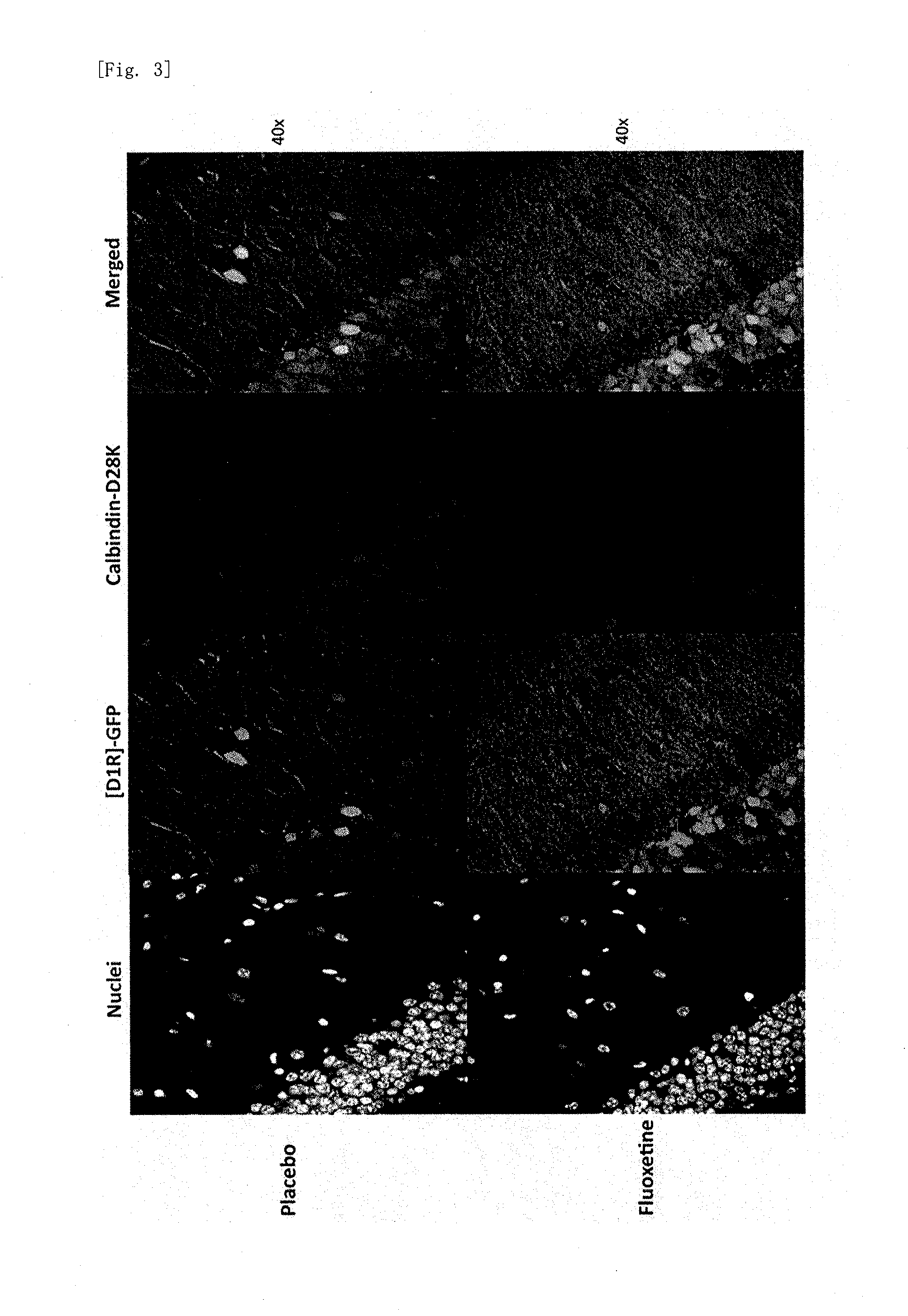Combination medicine for treatment of depression
a combination medicine and depression technology, applied in the field of antidepressants, can solve the problems of dependence as a social issue, unsatisfactory antidepressants, and high rate of recurrence after improvement of depressive phase, so as to improve the treatment of depression, and improve the effect of treatmen
- Summary
- Abstract
- Description
- Claims
- Application Information
AI Technical Summary
Benefits of technology
Problems solved by technology
Method used
Image
Examples
example 1
1. Establishment of Fluoxetine Chronic Administration Model and Induction of Dematuration of Hippocampal Dentate Gyrus
[0102]Mice (sex: male, strain: C57Bl / 6NCrS1c) were purchased from Japan SLC, and as a sustained-release antidepressant, a fluoxetine pellet (15 mg / (kg day)×14 days) as described below was subcutaneously implanted to each of the mice to prepare fluoxetine chronic administration mouse models. As the fluoxetine pellets, pellets capable of sustainably releasing fluoxetine (Sigma, #F132) were custom-made by Innovative Research of America. The method of subcutaneously implanting each pellet was as follows: a small incision about 5 mm was made in the neck skin of each mouse, a pellet was inserted through the incision to a depth of about 2 cm with tweezers for indwelling, and the skin was sutured.
[0103]After a fluoxetine pellet or a placebo pellet was subcutaneously implanted and 14 days of treatment was given, the gene expression in the hippocampal dentate gyrus was analyze...
example 2
[0118]Experiments were conducted in the same manner as in “1. Establishment of fluoxetine chronic administration model and induction of dematuration of hippocampal dentate gyrus” in Example 1 except that imipramine was used instead of fluoxetine. The mice treated with the imipramine pellet showed less mRNA expression of calbindin, desmoplakin, tryptophan 2,3-dioxygenase, and interleukin-1 receptor as compared to the mice treated with the placebo pellet (control), that is, showed the pattern of dematuration of hippocampal dentate gyrus. Further, increase in the mRNA expression of dopamine D1 acceptor was observed. The results are shown in FIG. 6.
example 3
[0119]In the same manner as in Example 1, a dopamine D1 receptor agonist, namely SKF81297 was administered to the chronic fluoxetine administration model mice in Example 1, and mRNA expression in the hippocampal dentate gyrus was examined. The results are shown in FIG. 7. FIG. 7 clearly shows the beneficial effects of the present invention on the depression-related genes. Further, the protein expression level was measured. The results are shown in FIG. 8. As shown in FIG. 8, it was revealed that, regarding the protein level as well, combination use of SKF81297 further increases the depression-related gene expression increased by fluoxetine. These results clearly show the beneficial effects of the present invention. It was also confirmed that, by the use of the method of the present invention, a dopamine D1 receptor agonist that, in combination with an antidepressant, improves the treatment of depression can be obtained.
[0120]The present invention is not limited to the embodiments an...
PUM
| Property | Measurement | Unit |
|---|---|---|
| pH | aaaaa | aaaaa |
| temperature | aaaaa | aaaaa |
| depth | aaaaa | aaaaa |
Abstract
Description
Claims
Application Information
 Login to View More
Login to View More - R&D
- Intellectual Property
- Life Sciences
- Materials
- Tech Scout
- Unparalleled Data Quality
- Higher Quality Content
- 60% Fewer Hallucinations
Browse by: Latest US Patents, China's latest patents, Technical Efficacy Thesaurus, Application Domain, Technology Topic, Popular Technical Reports.
© 2025 PatSnap. All rights reserved.Legal|Privacy policy|Modern Slavery Act Transparency Statement|Sitemap|About US| Contact US: help@patsnap.com



